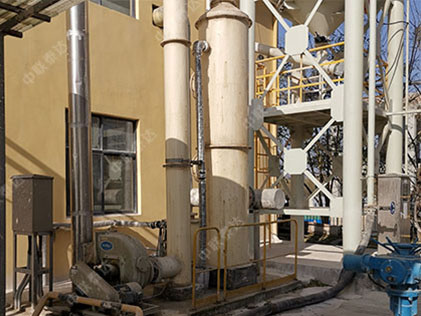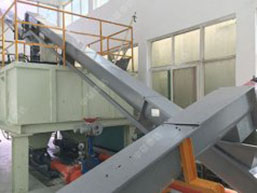With increase of waste water treatment plants and development of waste water treatment technology, there are more and more sludge produced during waste water treatment process. Although there existing many disposal methods, like thermal drying, composting and incineration, basic investment and running cost are pretty high. Meanwhile, by-products with high pollution like dioxin. Taeda® CAO alkaline stabilization drying method can realize sludge drying, solicitation and bacterium elimination with low investment cost, quick result and stable disposal effect. This method is more suitable for further treatment of dewatered sludge from small and medium sized waste water plants.
Sludge+Calcium Akaline Stablization Drying System is a kind of drying, stabilization and recycling method developed by Taeda based on contemporary new technologies at home and abroad for sludge from municipal waste water treatment plants by using of additives. During disposal process, quick lime is used as additives, stabilizer and heat generating agent. After drying, dewatering and modification, sludge can be reused as stable inorganic matters. Besides replacing auxiliary materials in construction industry, dried products can also be used for brick making, which helps recycling of sludge. This technology is featured in no secondary pollution, high safety level, low investment and waste reutilization. Calcium hydroxide will become calcium oxide after dewatering. Based on this principle, additives can be recycled and reutilized after materials are calcined under high temperature, which realizes circular use of raw materials.
This technology uses lime and sludge water formation reaction of high temperature and high alkali environment. In high temperature evaporation of water environment, this system can achieve the sludge deep dehydration to kill the poisonous harmful pathogenic bacteria. In addition, it can passivate the heavy metals and eliminates the smell and other functions. Finally, realize sludge dehydration, harmlessness and stabilization. Effectively solve the sludge dehydration of environmental pollution and social problems to ensure the normal operation of the sewage treatment plant.
△. Alkaline stabilization drying technology realizes thorough sterilization and deodorization aim.
△.. This system holds wide input capacity which ranges from 100kg to ten ton per hour.
△. Reaction temperature reaches 55 to 80 degrees which holds passivation function for about 9 heavy metals.
△. Less investment cost and short construction period.
Technical introduction:
This technology uses lime and sludge water formation reaction of high temperature and high alkali environment. In high temperature evaporation of water environment, this system can achieve the sludge deep dehydration to kill the poisonous harmful pathogenic bacteria. In addition, it can passivate the heavy me
tals and eliminates the smell and other functions. Finally, realize sludge dehydration, harmlessness and stabilization. Effectively solve the sludge dehydration of environmental pollution and social problems to ensure the normal operation of the sewage treatment plant.
Process flow

|
Disposal capacity |
Power/kw |
Area of system/m2 |
Remarks |
|
Running power |
Total power |
Area of core equipment
|
Area of system
|
|
1t/h |
17.5 |
30 |
20 |
90-125 |
Provide complete products and perfect service. |
|
2t/h |
22.5 |
40 |
24 |
125-175 |
|
3t/h |
30 |
50 |
32 |
175-300 |
|
4-5t/h |
45 |
70 |
48 |
300-400 |
|
7.5t/h |
55 |
90 |
60 |
350-450 |
We will provide complete plans for you:
Sewage sludge contains nutrients such as nitrogen and phosphorus and organic materials to make it with the fertilizer manufacturing and as fuel for the basic conditions and industrial waste water with high content of sewage sludge may contain more heavy metal ions or toxic and harmful chemical substances, such as adsorption of organic halogens (AOX), anionic surfactant (LAS), polycyclic aromatic hydrocarbons (PAH). Therefore, sewage sludge has a dual nature: resources and hazards. Many domestic sludge treatment and disposal methods, commonly used concentration, digestion, dehydration, drying, effective use of (mainly agricultural, landfill and incineration of different methods of treatment and disposal, or use one of several methods for disposal of the combination. Different disposal methods have different requirements for the pretreatment, and in fact some of the previous processing requirements are part of this approach. The final outlet of sludge is partial or full use of resources or in some form to return to the environment.
1. Reduction
Compared with other treatment methods of sludge, the reduction of mechanical dehydration of sludge is a very economical and effective method. Different mechanical dehydration method can be adopted to improve the solid content of the mud, so as to facilitate the subsequent processing.
2. Harmlessness and stabilization
Alkaline stabilization adds lime, cement kiln dust and other alkaline substances to sludge. the sludge’s pH value is higher than 12 which will be maintained for a period of time. With strong alkali and lime, lots of heat energy is released to kill pathogens. It also can reduce odor and heavy metal passivation. Sludge which has been disposed can be directly applied to the field. The two main treatment methods of alkaline stabilization: the rapid drying of the sludge after alkaline; the other is stabilization through mechanical dump or other methods.
3. Heat drying
Heat drying uses heat to dry sludge. Dried sludge granular or powder, the volume is only the original 1 / 5 to 1 / 4. Because water content is below 10%, microbial activity was completely inhibited and avoid the products mildewy smell, which leads to easy storage and transportation. Thermal drying process of high temperature sterilization effect is very thorough. The product can completely meet the health indicators and to improve the performance of the sludge. The product can be used as alternative energy sources which can be applied to land. Taida thermal drying equipment is with high degree of automation, good safety performance and high thermal conversion efficiency.
4. Incineration
By incineration, the sludge can be used to generate electricity and the sludge can be reduced to the maximum extent. In recent years, incineration, because of the adoption of appropriate pretreatment and incineration means, sludge can realize heat energy self-sufficient heat energy. It can also meet the needs of more and more stringent environmental requirements and to deal adequately with inappropriate on the resource utilization of sludge. Because of its poor weather conditions, it is economical and effective to use incineration to deal with the large cities with high transportation costs . In the process of burning all the bacteria, pathogens are completely killed. Toxic and harmful organic residues are oxidized and decomposed. Incineration ash can be used as raw materials for production of cement, so that heavy metal is fixed in the concrete and avoid reentering the environment. The shortage is that the incineration process will produce dioxin and other air pollutants. The most widely used burning equipment is fluid bed incinerator. When the water content of sludge reached more than 38%. The sludge will not need auxiliary fuel direct combustion. Sludge incineration is more common in Japan, Europe and the United States. In EU, the proportion of 1992 sludge incineration is 11%, compared with an increase of 38% in 1984; Japan has 61% of the sludge by incineration.
The main processes of sludge incineration are presented following:
Sludge--concentration---digestion--dehydration--incineration--sanitary landfill
Sludge incineration ash can be used as a landfill admixture or used as brick and other building materials.
 中文
中文 English
English Home
Home









